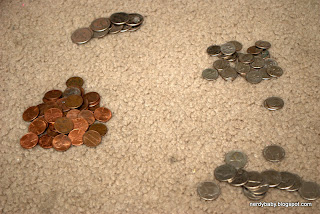J's been obsessed with his piggy bank since a very young age. Under close adult supervision, even kids under 2 can learn to take money in and out of the piggy bank (I'm sure you can find one super cheap at the dollar store). Ours was a shower gift from a friend. Also, we never walk past money on the ground anymore since J is always interested in filling his bank.
Toddler age:
*Take the money out of the piggy bank.
*Identify that there are different coins that represent different amounts of money (don't go into too much detail).
*Start counting with the money (count as high as your child has attention span for).
*Put coins back into piggy bank.
*Shake piggy bank - what kind of sound do you hear?
*Is the piggy bank heavy or light?
Older Toddler/Young Preschool age:
*Take out the money from the piggy bank.
*Sort the money into different piles, one for each type of coin.
*Identify the types of coins by name (ie. penny, nickel, dime, quarter).
*Start the conversation that pennies equal 1, nickels equal 5, dimes equal 10 (even if they are the smallest!), and quarters equal 25.
*Count pennies as high as your child can given their attention span.
*See if you can start counting by 5's or 10's (probably not, but worth the try).
*Count coins as your kid puts them back into the piggy bank.
Older Preschool/Early Elementary:
*Sort money into different piles by coin type.
*Count how many of each coin there are.
*Introduce addition: if your child has 3 pennies in his bank and you find 2 pennies (say on the dresser) and add them to his bank, count how many he now has.
*Which is more money: 3 pennies or 7 pennies?
*If 7 pennies are more than 3 (hope I didn't ruin the above bullet), and dimes are actually worth 10 pennies, can you identify with is worth more: 7 pennies or 1 dime?
*Count by 5's for the nickels and see how much money you have in nickels (early multiplication).
*Count by 10's for the dimes and see how much money you have in nickels (early multiplication).
*Have your child divide the pennies into equal piles (I recommend one per person in the house). How many does each person get? (Early division)
*Have a treat that costs 8 cents and see if your child can come up with a combination of coins that equal 8 cents (addition/subtraction). If your child has 11 cents and it cost 8 cents for the treat, how much money does he/she have left? (yay, math word problems aren't really that scary).
*Take your child to a party store, where you can buy little fun, cheap toys with his/her coins. This can show that money actually represents something.
*Consider allowance for chores to add to the wealth.
 |
| Yay, math! |




My kids are really into money right now! There's definitely a lot to learn from it!
ReplyDeleteI think coin wrappers can also help your children understand easier the concept of counting money and its different denominations. Anyway, it’s good to see that your kids are learning the value of money. You must also let them learn the importance of saving while they’re still young. ->Harriett Faulks
ReplyDelete